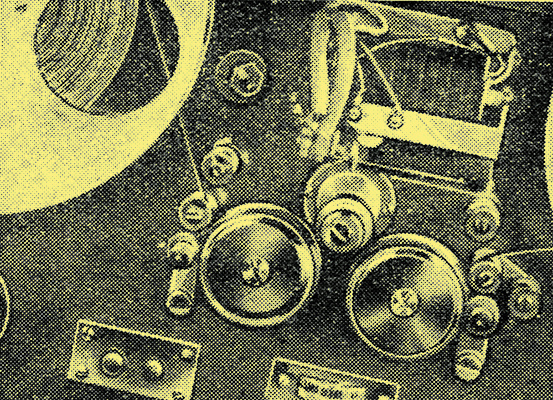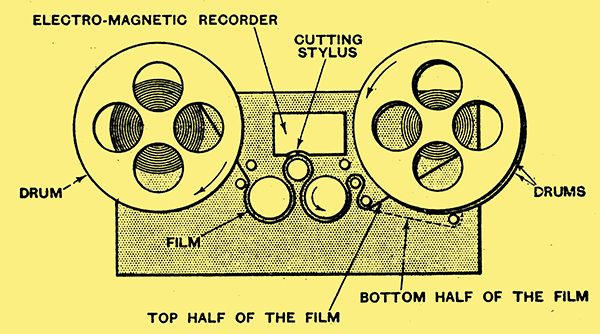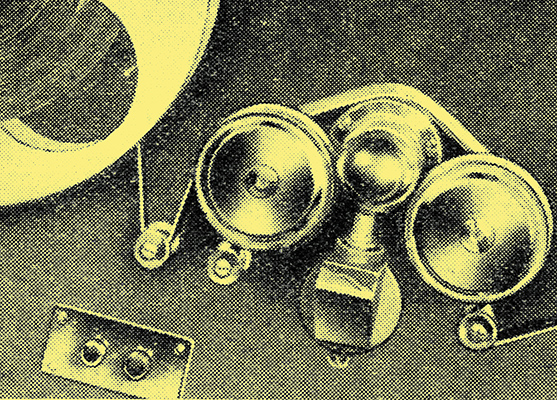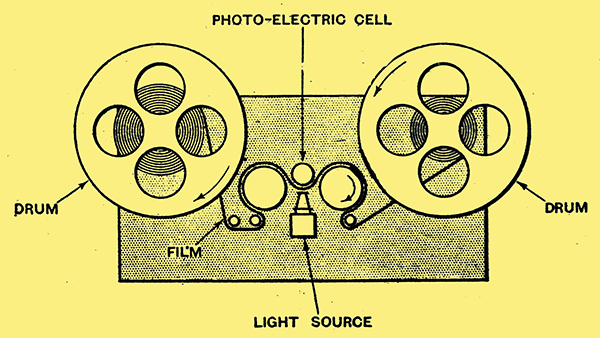|
A New System of Electro-magnetic Recording on Film.
It seems more than likely that compact spools of film, or even of paper tape, will eventually be used in domestic gramophones, either in place of, or as an alternative to, the present-day type of disc records. A promising method of recording sound on film is here described by a Continental contributor.


The recording apparatus, with diagrammatic sketch to show how the film is divided into two lengths.
The opinion is growing that, despite progress made in sound-on-disc recording and reproducing, the sound-on-film process will probably, as time proceeds, supersede all other methods so far as the domestic gramophone is concerned. The lowest frequencies are easily recorded on film, but the recording of the higher frequencies above, say, 5,000 or 6,000 Hz is still difficult at film speeds determined with regard to photographic considerations such as the number of frames per second. But for purely sound recording no such limitation exists, and matters can be so arranged that the upper limit of recorded frequencies lies in the region of 10,000 kHz.
Up till now the recording of sound-on-film has been practically ruled out for the amateur owing to the costly apparatus involved in the recording process and in the developing and making of prints. The mechanical recording on discs (by the amateur) requires a minimum of special apparatus, and has been instrumental in making home recording a practical proposition. So it is probable that the new system of sound recording on film, recently developed on the Continent, will appeal both to the musician who appreciates extended frequency range and long playing time, and to all those interested in the fascinating hobby of home recording.
The new film recording is electro-mechanical, and so is basically similar to the sound-on-disc method, but reproduction is obtained on lines similar to those followed in the ordinary talkies in which the variable-area system is employed. The film used is 16 mm. wide and very thin (5/100 mm), is not influenced by light, and the mass of it is absolutely opaque. A point to be stressed is that it is not a photographic film, therefore it is cheap and easy to handle. Full advantage can be taken of the fact that at present it is possible to design a recording movement which will have a practically level frequency characteristic up to about 8,000 kHz. For sound-on-disc work the usual limit (due to surface noise, etc.) is 5,500 kHz.
The film is passed at constant speed between a drum and a diamond cutting stylus actuated by an electro-magnetic recorder. When no modulation is applied to the recorder movement, the film is out in two strips, the edges being straight. When modulation is applied, the cutting point is given a lateral motion while cutting the film; thus, the two strips show undulations on the inner edges corresponding to the modulation, and two copies are obtained at one operation. For reproduction the jagged edge of one of these is interposed between a photo-electric cell and a narrow beam of light. Hence the amount of light on the photo-electric cell will depend on the modulation recorded on the edge of the strip. The resulting variations in electric current will, after suitable amplification, feed the loud speakers.
Good monitoring of the recorded sound is possible, as the reproducing instrument can be fitted alongside the recorder; there is no delay while waiting for developing and printing of the film. Another advantage is that, as the mass of the film is entirely opaque, no scratches will show up and cause clicks and background noise, as is the case with the photographic film. In the mechanical recording on film the amplitudes do not exceed 0.1 mm., and so a slit of light of that length will be sufficient, and the background noise due to the photo-electric cell will be considerably reduced.
Output and Frequency Range


The reproducing apparatus is basically similar to that dealing with ordinary variable-area sound films.
It is obvious that in sound films in which the variable area system is employed, the maximum output will be obtained when the difference between the opaque part of the sound track and the transparent part is at a maximum. The above condition for maximum output is fulfilled with the system now described, as the film is absolutely opaque and no transparent part exists, while with normal recording the opaque part is never entirely opaque, while the transparent part is never entirely transparent. So far as frequency range is concerned, the new system, while being superior to the sound-on-disc method, is inferior to what can be done in sound recording on photographic film. Another disadvantage is the greater amplification required, owing to the small amplitudes of /the mechanically recorded sound on film.
When it is desired to make a great number of copies, they are produced photographically from the original jagged strip. It is understood that during the printing process use is made of an optical system to enlarge the amplitudes ten times, while the length of the cycle is not altered. Thus, the copies obtained are nearly equivalent to those which would be obtained from a photographically recorded sound film.
A roll of film, 30 cm. diameter, represents a playing time of about 45 minutes. Another model is being developed which will provide an uninterrupted programme for several hours. For reproduction, a photographic film will be used, carrying eight separate sound tracks, which are automatically switched-in one after the other.
The writer has not yet had an opportunity of carrying out measurements on the instrument, nor of putting it through severe tests. But, after close examination of its special features, and as far as could be judged aurally, the conclusion was reached that it is superior to the ordinary disc. There is no doubt that it will open up a new field, and, while providing the amateur with a practical home recorder, will offer him plenty of scope for experiment.
|